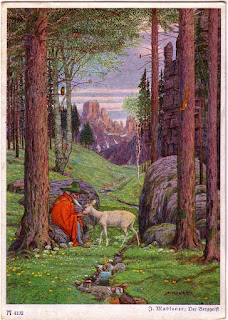Other depictions that are clearly Wayland are found on some 8th/9th century carved stones called Ardre image stones, and an 8th century whale-bone chest called the Franks Casket.
Anglo-Saxon culture made frequent reference to the smith. In Beowulf, we are told the source of the hero's armor:
If the battle takes me, send back
this breast-webbing that Weland fashioned
and Hrethel gave me, to Lord Hygelac.
Fate goes ever as fate must. (lines 452-55, Heaney translation)
Another Anglo-Saxon poem, Waldere, mentions the hero's sword made by Weland. In Alfred the Great's translation of Boethius, he laments "What now are the bones of Wayland, the goldsmith preeminently wise?" Medieval romances often included swords made by Wayland.
A megalithic mound in the Berkshire Downs is known as Wayland's Smithy, about which was the legend that, if one left a horse tethered there overnight with a silver coin, the horse would be shod by morning.
More than just an image and symbol of smithing, the poem in the Poetic Edda, the Völundarkviða (Old Norse: "The lay of Völund"), tells that he was captured and crippled (similar to Hephaestus, the lame smith of the Greek pantheon) in order to be forced to work for a king. I'll tell you that story tomorrow.
du.jpg)


